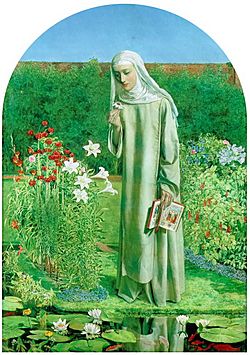Convent Thoughts facts for kids
Quick facts for kids Convent Thoughts |
|
|---|---|
 |
|
| Artist | Charles Allston Collins |
| Year | 1850–51 |
| Medium | Oil on canvas |
| Dimensions | 84 cm × 59 cm (33 in × 23 in) |
| Location | Ashmolean Museum, Oxford |
Convent Thoughts is a beautiful painting created by the artist Charles Allston Collins. He worked on it between 1850 and 1851. This artwork was shown to the public at the Royal Academy of Arts in 1851. It is a well-known example of the detailed style used by the Pre-Raphaelite artists.
Contents
Exploring "Convent Thoughts"
What the Painting Shows
The painting features a young nun. She is standing in a garden with high walls. This garden is filled with many different flowers. Each flower is painted with amazing detail.
The nun is looking at a passion flower. This flower is a symbol of the crucifixion of Christ. In her left hand, she holds an illuminated book. This book is called a Breviary or Book of Hours. She holds it in a way that shows us pictures of the Annunciation and the Crucifixion.
Her clothes tell us she is a novice. This means she is training to become a full nun. She is likely thinking about her final vows. These are promises she will make to dedicate her life to her faith.
The Artist and His Style
Charles Allston Collins painted Convent Thoughts. He was not officially a member of the Pre-Raphaelite Brotherhood. However, he strongly agreed with their ideas. He painted in their very detailed style.
The Pre-Raphaelites were a group of English artists. They wanted to return to the bright colors and detailed style of art. This was before the time of the artist Raphael. They believed art had become too dull and formal.
Collins painted the flowers in the garden of Thomas Combe. Combe was one of the first people to collect Pre-Raphaelite paintings. For a long time, people thought Combe's housemaid, Frances Sarah Ludlow, was the model for the nun. But new research suggests the face is most likely that of Sarah Eliza Hackett.
A Famous Supporter: John Ruskin
Convent Thoughts is important in the history of Pre-Raphaelite art. At first, many people did not like the Pre-Raphaelite style. But an important art critic, John Ruskin, changed some opinions.
On May 13, 1851, Ruskin wrote a letter to The Times newspaper. In his letter, he praised the Pre-Raphaelite paintings at the Academy exhibition. He especially liked Convent Thoughts.
Ruskin wrote about how well the plants were painted. He said the picture would be "invaluable" to him as a study of flowers. He was very impressed by the accurate details.
Interestingly, Ruskin mentioned a water plant called Alisma Plantago. He said it was drawn perfectly in the painting. However, it has recently been pointed out that this plant is not actually in the picture!
Where to Find the Painting Today
Thomas Combe bought Convent Thoughts after it was painted. Later, his wife, Martha Combe, left the painting to the Ashmolean Museum in Oxford. You can still see Convent Thoughts in the museum's collection today.

